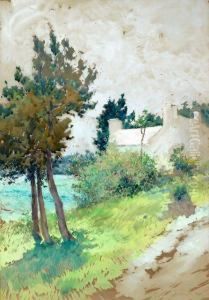Ross Sterling Turner Paintings
Ross Sterling Turner was an American artist renowned for his watercolor paintings, born in 1847 in Westport, New York. Turner's artistic journey began with his education in architecture at the Chandler Scientific School of Dartmouth College, an unusual start for a painter that later influenced his precise and structured approach to watercolor painting. Despite his architectural training, Turner's passion for painting led him to pursue art as his primary career.
After completing his studies, Turner traveled to Europe, a rite of passage for many artists of his time, to further his education in the arts. He studied in Paris, immersing himself in the vibrant artistic scene of the late 19th century, and honed his skills in watercolor. It was during this period that Turner developed his distinctive style, characterized by a delicate touch, nuanced use of color, and a focus on light and atmosphere.
Upon returning to the United States, Turner settled in Salem, Massachusetts, where he became a significant figure in the local art community. His works were celebrated for their innovative approach to watercolor, challenging the medium's boundaries and elevating it to the status of oil painting. Turner's subjects ranged from landscapes and seascapes to floral compositions and domestic scenes, each marked by his meticulous attention to detail and mastery of color.
Turner was also an influential educator, teaching watercolor techniques to a new generation of artists. He believed in the importance of direct observation and encouraged his students to work en plein air, a practice that was gaining popularity among American Impressionists at the time.
Ross Sterling Turner's contributions to American art were recognized during his lifetime, and his works were exhibited in numerous prestigious venues, including the Boston Art Club and the Pennsylvania Academy of the Fine Arts. Today, his paintings are held in several important collections and continue to be appreciated for their beauty and technical skill.
Ross Sterling Turner passed away in 1915, leaving behind a legacy as one of America's foremost watercolorists of the late 19th and early 20th centuries. His dedication to the medium of watercolor and his innovative techniques have inspired countless artists and continue to captivate audiences to this day.














